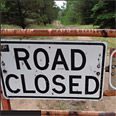Legislation & Regulation
Legislative and Regulatory Update
February 2012 by Scott Harn
• Our Federal LandlordRange Magazine has an excellent article titled “Our Federal Landlord” that details the federal government’s unconstitutional purchase and control of public lands.
Dr. Michael S. Coffman writes, “The U.S. Constitution specifically prohibits the federal government from owning large blocks of land. The reason for this has become obvious in the past 50 years. Rural residents who make their living from Western federal lands today are finding that Washington is regulating them toward bankruptcy while an ill-informed population in the East is complicit by default.”
The article covers the history of federal land grabs and the laws and treaties that have been promulgated over the past hundred years that are in direct conflict with the U.S. Constitution. It’s available free at rangemagazine.com and is a must read. (7-page pdf file -- may take a minute to load.)
• One down, two to go
Public Lands for the People (PLP) successfully appealed the injunction that started much of the suction gold dredging fiasco in California. This was the taxpayer lawsuit filed by Leeon Hillman of the Karuk Tribe in Alameda County Superior Court.
The court ruled, “Because recently enacted legislation prohibits suction dredge mining in the near term and at least until environmental review is completed and new regulations are in place, there is no longer a threat of immediate irreparable harm justifying provisional relief in the form of a preliminary injunction. Accordingly, we shall reverse the trial court’s order.”
This is only the first hurdle—it clears the way for PLP’s challenge of SB 670 and AB 120, the two California bills that are currently holding up the issuance of dredge permits.
Meanwhile, the California Department of Fish & Game announced that they anticipate releasing new suction dredging regulations as soon as February 2012. We’ll have to wait and see what those look like, but we’re not holding our breath for anything reasonable based on the process so far.
• Challenging timing windows in Washington State
Washington State miner Bruce Beatty has filed a complaint in Superior Court after exhausting his appeals with the Pollution Control Hearing Board over the ridiculous timing windows for placer mining in the state.
The Washington Department of Fish & Wildlife (WDFW) wanted to limit Beatty’s work window to two weeks during the middle of winter. He applied for an exception, but was denied by the WDFW, and that denial was later affirmed by the Pollution Control Hearings Board.
It’s a strong case that should finally put the unwarranted and unreasonable timing windows to rest, but funds are needed to get it through court. Contributions can be made to Public Lands for the People, 7194 Conejo Dr, San Bernardino, CA 92404. Make sure you designate your contribution to support Bruce Beatty.
• More roadblocks to mining
The current administration continues to appease environmental organizations and place additional roadblocks in front of public land users. Here’s the latest:
The US Fish & Wildlife Service (FWS) approved petitions to consider over 425 new species as threatened or endangered in 2011. The agency is also considering a new Endangered Species Act definition that would change the way they define “significant portion of its range.” The new definition would require prohibitions across all of a species range even if it is determined that the species is considered threatened or endangered on only a portion of that range.
Interior Secretary Ken Salazar has placed a 20-year mineral withdrawal on over 1 million acres near Grand Canyon National Park.
“This unilateral, arbitrary decision is an extreme action that is not based on science,” said Doc Hastings (R-WA), chairman of the House Natural Resources Committee.
“The Department’s own Environmental Impact Statement does not justify the withdrawal and studies have shown that uranium mining outside the park’s border can be done safely with negligible environmental impacts. We can responsibly mine while still protecting the environment. It doesn’t have to be the all or nothing approach that the Administration has unfortunately decided to take,” said Hastings.
The BLM and Forest Service are considering additional prohibitions in ten Western states to protect the “greater sage-grouse.”
The agencies are attempting to side-step the 1872 Mining Law by limiting occupancy and land use in areas where the sage-grouse is present. The news release issued by BLM stated that “human-caused disturbance in priority habitat would be limited to less than 2.5% of the species’ total habitat, regardless of surface ownership. In priority habitat areas where more than 2.5% of the surface area has already been disturbed, the BLM would not authorize any further disturbance.”
The proposed alternative would essentially obtain the results of an Endangered Species Act listing without going through the ESA process.
“A Report on National Greater Sage-Grouse Conservation Measures” is available on the Internet. (It may take a minute or two to load.)
A brief public comment period will close on February 7, 2012. Comments for the eastern region (Colorado, Wyoming, North Dakota, South Dakota, and parts of Montana and Utah) can be emailed to sageeast@blm.gov
Comments for the western region (California, Idaho, Nevada, Oregon, and parts of Montana and Utah) can be emailed to sagewest@blm.gov

CA Supreme Court Rules Against Rinehart - But There Is A Solution
Even if the California Supreme Court had ruled in favor of Rinehart, suction dredge miners would be facing the wrath of the State Water Resources Control Board...
Selenium, Mercury and Suction Dredging—Studies Contradict CA State Water Resources Board
Federal and state regulatory agencies often cite mercury and methyl mercury in our waterways as a major factor for further restrictions on placer mining, and on suction gold dredge mining, in particular. However, these regulatory agencies are minimizing selenium and its neutralizing effects.
Court Says Emergency Rule in California Unjustified
Superior Court Judge Karen L. Dixon granted the temporary restraining order on July 3, 2013.
Significant Progress for California Suction Gold Dredgers
It was a milestone day in the battle to maintain the rights of miners to dredge on federal mining claims in California.
Legislative and Regulatory Update
• BLM to raise fees again
• Roadless Rule stands
• Suit filed over dredging restrictions in Washington State
• NWMA lends support
• California suction gold dredging lawsuits progressing
Miners Fight Back Against Road Closures
 In the meeting, we presented Ms. Skalski with the various court cases from the 9th Circuit Court on these settled law cases and she was mortified.
In the meeting, we presented Ms. Skalski with the various court cases from the 9th Circuit Court on these settled law cases and she was mortified.
Legislative and Regulatory Update
• Forest Service to revisit 228 regulations
• WOTUS Executive Order suspended
Subscription Required:
The Bawl Mill
• Ask the Experts - ...Worth further investigation?
• Ask the Experts - Processing sulfide ore without mercury or cyanide.
• Regarding "Good Assays and Bad"
• New "Employment" Category
• 4 Keys to Successful Nugget Hunting
• A High Price to Pay
• Eolian Placer Gold
• All the Gold Ever Mined...
• The Basics of Geophysical Exploration
• Targeted for a Tax Audit
• Feds Order Closure of Idaho Mine
• Trying Out the New Highbanker
• A Gold Mine on a Washington Beach?
• Melman on Gold & Silver
• Mining Stock Quotes and Mineral & Metal Prices
Free:
Ask the Experts - Old workings & tailings: What are my options?








